Strategic Analysis Report: Klarna's Business Strategy Evaluation
VerifiedAdded on 2023/01/13
|18
|5833
|78
Report
AI Summary
This report provides a comprehensive analysis of Klarna's business strategy, starting with an introduction to Klarna, a Swedish online payment service provider. It examines the influence of macro-environmental factors using PESTEL analysis, highlighting political, economic, social, technological, environmental, and legal impacts. The report then delves into Klarna's internal environment and capabilities using the McKinsey 7S model and VRIO analysis, assessing its strategy, structure, systems, skills, staff, style, and shared values. A SWOT analysis is also included to identify strengths, weaknesses, opportunities, and threats. Furthermore, the report explores competitive analysis, applying theories and models for strategic planning to achieve Klarna's business objectives, culminating in a strategic management plan. The report concludes with a summary of findings and references.
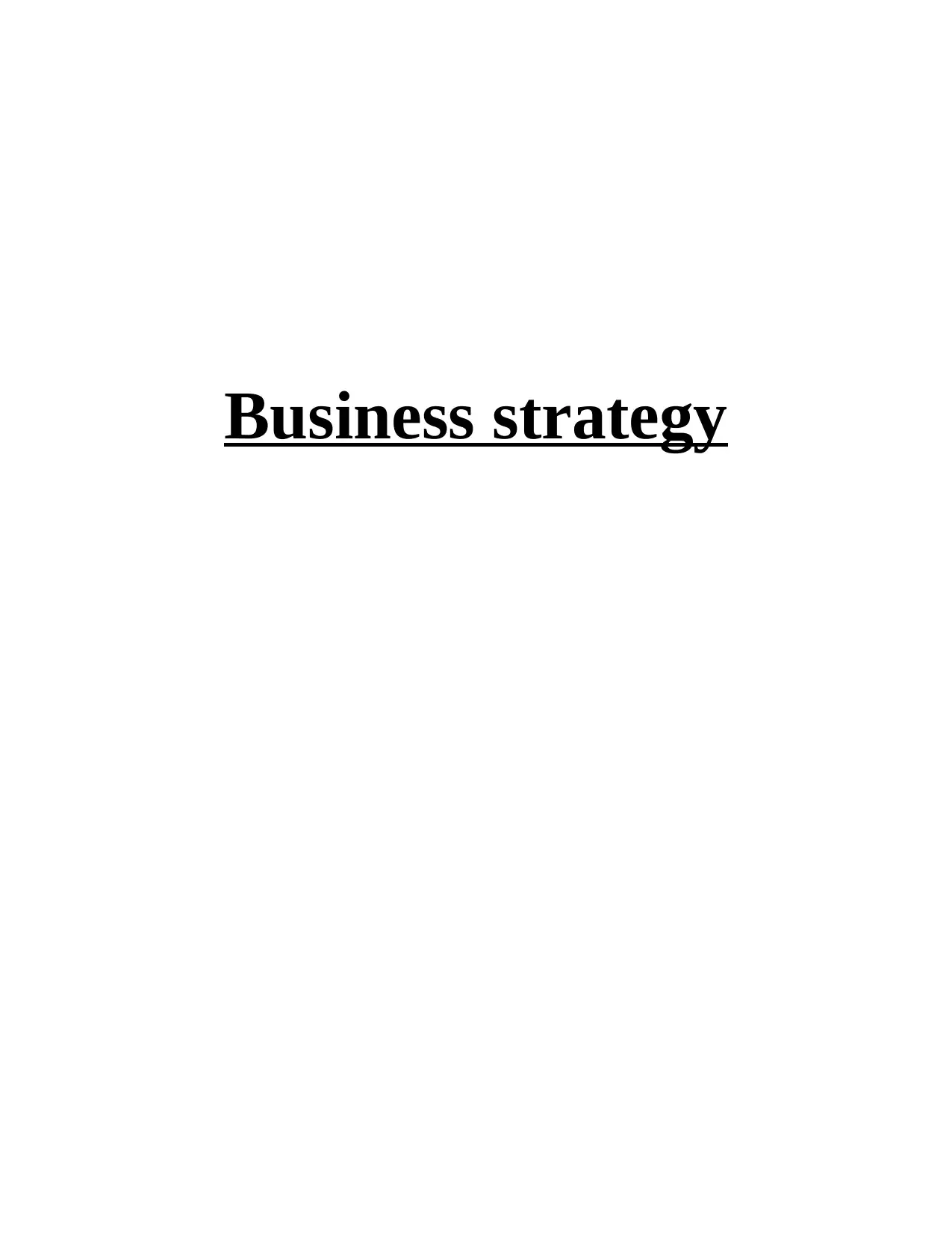
Business strategy
Paraphrase This Document
Need a fresh take? Get an instant paraphrase of this document with our AI Paraphraser
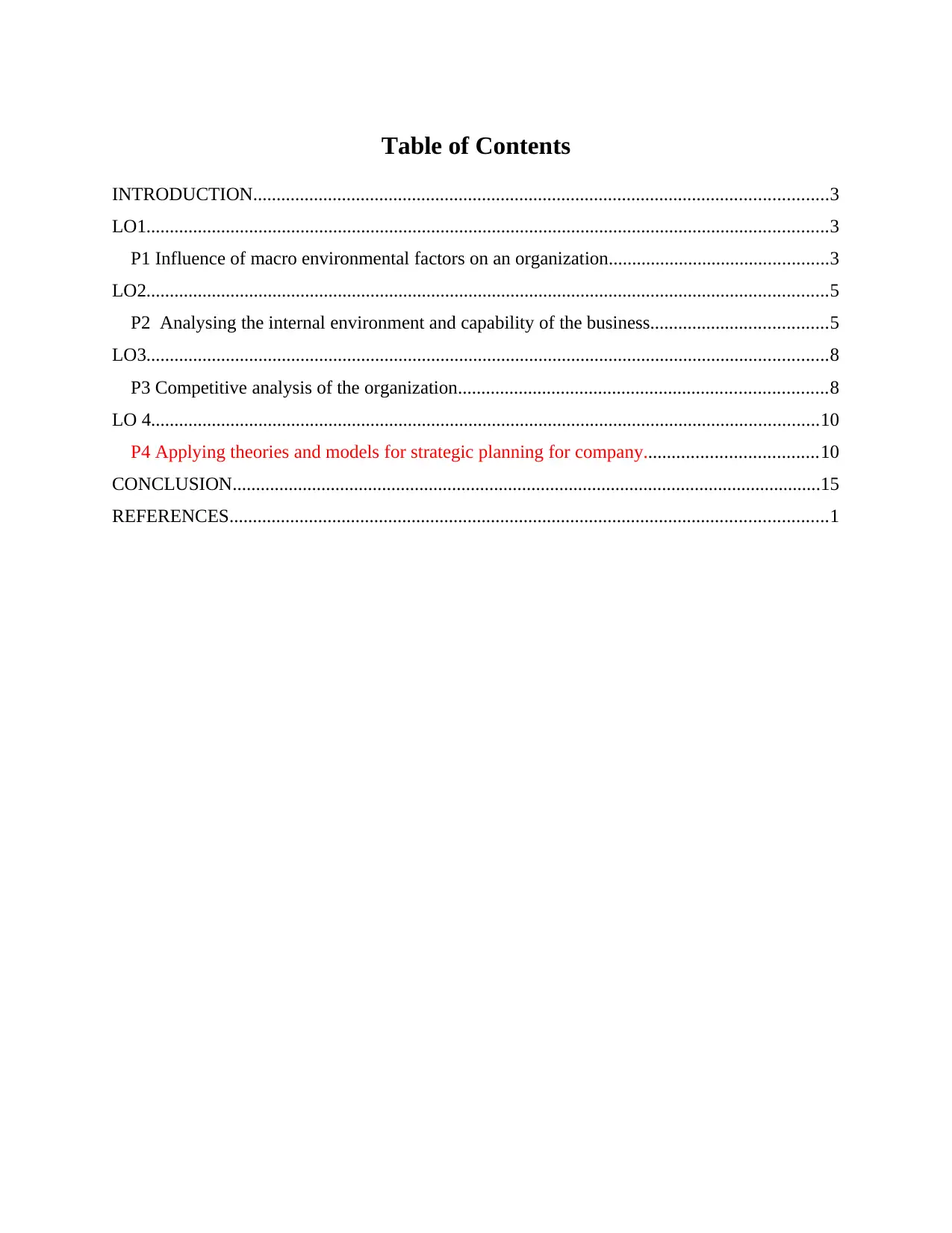
Table of Contents
INTRODUCTION...........................................................................................................................3
LO1..................................................................................................................................................3
P1 Influence of macro environmental factors on an organization...............................................3
LO2..................................................................................................................................................5
P2 Analysing the internal environment and capability of the business......................................5
LO3..................................................................................................................................................8
P3 Competitive analysis of the organization...............................................................................8
LO 4...............................................................................................................................................10
P4 Applying theories and models for strategic planning for company.....................................10
CONCLUSION..............................................................................................................................15
REFERENCES................................................................................................................................1
INTRODUCTION...........................................................................................................................3
LO1..................................................................................................................................................3
P1 Influence of macro environmental factors on an organization...............................................3
LO2..................................................................................................................................................5
P2 Analysing the internal environment and capability of the business......................................5
LO3..................................................................................................................................................8
P3 Competitive analysis of the organization...............................................................................8
LO 4...............................................................................................................................................10
P4 Applying theories and models for strategic planning for company.....................................10
CONCLUSION..............................................................................................................................15
REFERENCES................................................................................................................................1
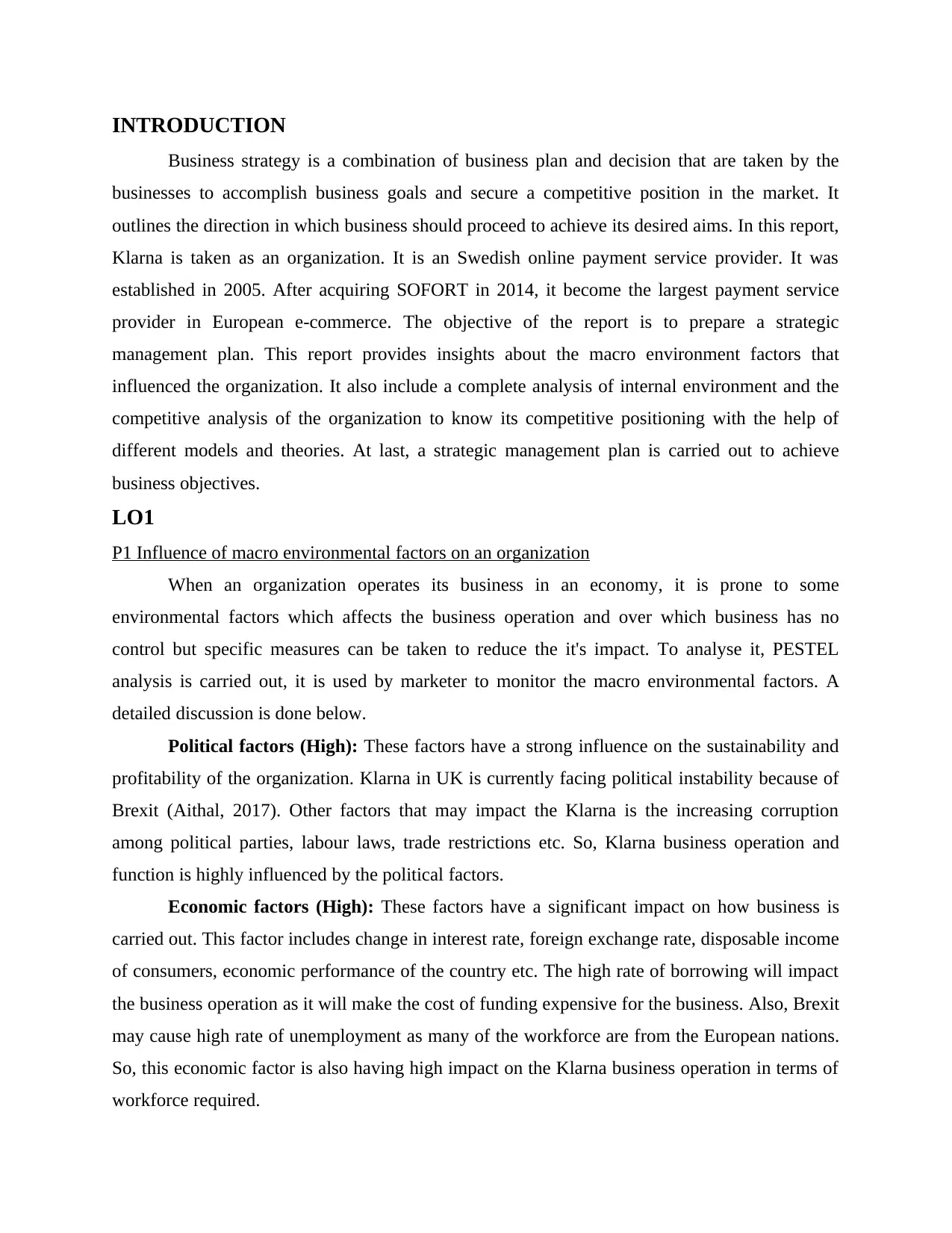
INTRODUCTION
Business strategy is a combination of business plan and decision that are taken by the
businesses to accomplish business goals and secure a competitive position in the market. It
outlines the direction in which business should proceed to achieve its desired aims. In this report,
Klarna is taken as an organization. It is an Swedish online payment service provider. It was
established in 2005. After acquiring SOFORT in 2014, it become the largest payment service
provider in European e-commerce. The objective of the report is to prepare a strategic
management plan. This report provides insights about the macro environment factors that
influenced the organization. It also include a complete analysis of internal environment and the
competitive analysis of the organization to know its competitive positioning with the help of
different models and theories. At last, a strategic management plan is carried out to achieve
business objectives.
LO1
P1 Influence of macro environmental factors on an organization
When an organization operates its business in an economy, it is prone to some
environmental factors which affects the business operation and over which business has no
control but specific measures can be taken to reduce the it's impact. To analyse it, PESTEL
analysis is carried out, it is used by marketer to monitor the macro environmental factors. A
detailed discussion is done below.
Political factors (High): These factors have a strong influence on the sustainability and
profitability of the organization. Klarna in UK is currently facing political instability because of
Brexit (Aithal, 2017). Other factors that may impact the Klarna is the increasing corruption
among political parties, labour laws, trade restrictions etc. So, Klarna business operation and
function is highly influenced by the political factors.
Economic factors (High): These factors have a significant impact on how business is
carried out. This factor includes change in interest rate, foreign exchange rate, disposable income
of consumers, economic performance of the country etc. The high rate of borrowing will impact
the business operation as it will make the cost of funding expensive for the business. Also, Brexit
may cause high rate of unemployment as many of the workforce are from the European nations.
So, this economic factor is also having high impact on the Klarna business operation in terms of
workforce required.
Business strategy is a combination of business plan and decision that are taken by the
businesses to accomplish business goals and secure a competitive position in the market. It
outlines the direction in which business should proceed to achieve its desired aims. In this report,
Klarna is taken as an organization. It is an Swedish online payment service provider. It was
established in 2005. After acquiring SOFORT in 2014, it become the largest payment service
provider in European e-commerce. The objective of the report is to prepare a strategic
management plan. This report provides insights about the macro environment factors that
influenced the organization. It also include a complete analysis of internal environment and the
competitive analysis of the organization to know its competitive positioning with the help of
different models and theories. At last, a strategic management plan is carried out to achieve
business objectives.
LO1
P1 Influence of macro environmental factors on an organization
When an organization operates its business in an economy, it is prone to some
environmental factors which affects the business operation and over which business has no
control but specific measures can be taken to reduce the it's impact. To analyse it, PESTEL
analysis is carried out, it is used by marketer to monitor the macro environmental factors. A
detailed discussion is done below.
Political factors (High): These factors have a strong influence on the sustainability and
profitability of the organization. Klarna in UK is currently facing political instability because of
Brexit (Aithal, 2017). Other factors that may impact the Klarna is the increasing corruption
among political parties, labour laws, trade restrictions etc. So, Klarna business operation and
function is highly influenced by the political factors.
Economic factors (High): These factors have a significant impact on how business is
carried out. This factor includes change in interest rate, foreign exchange rate, disposable income
of consumers, economic performance of the country etc. The high rate of borrowing will impact
the business operation as it will make the cost of funding expensive for the business. Also, Brexit
may cause high rate of unemployment as many of the workforce are from the European nations.
So, this economic factor is also having high impact on the Klarna business operation in terms of
workforce required.
⊘ This is a preview!⊘
Do you want full access?
Subscribe today to unlock all pages.

Trusted by 1+ million students worldwide
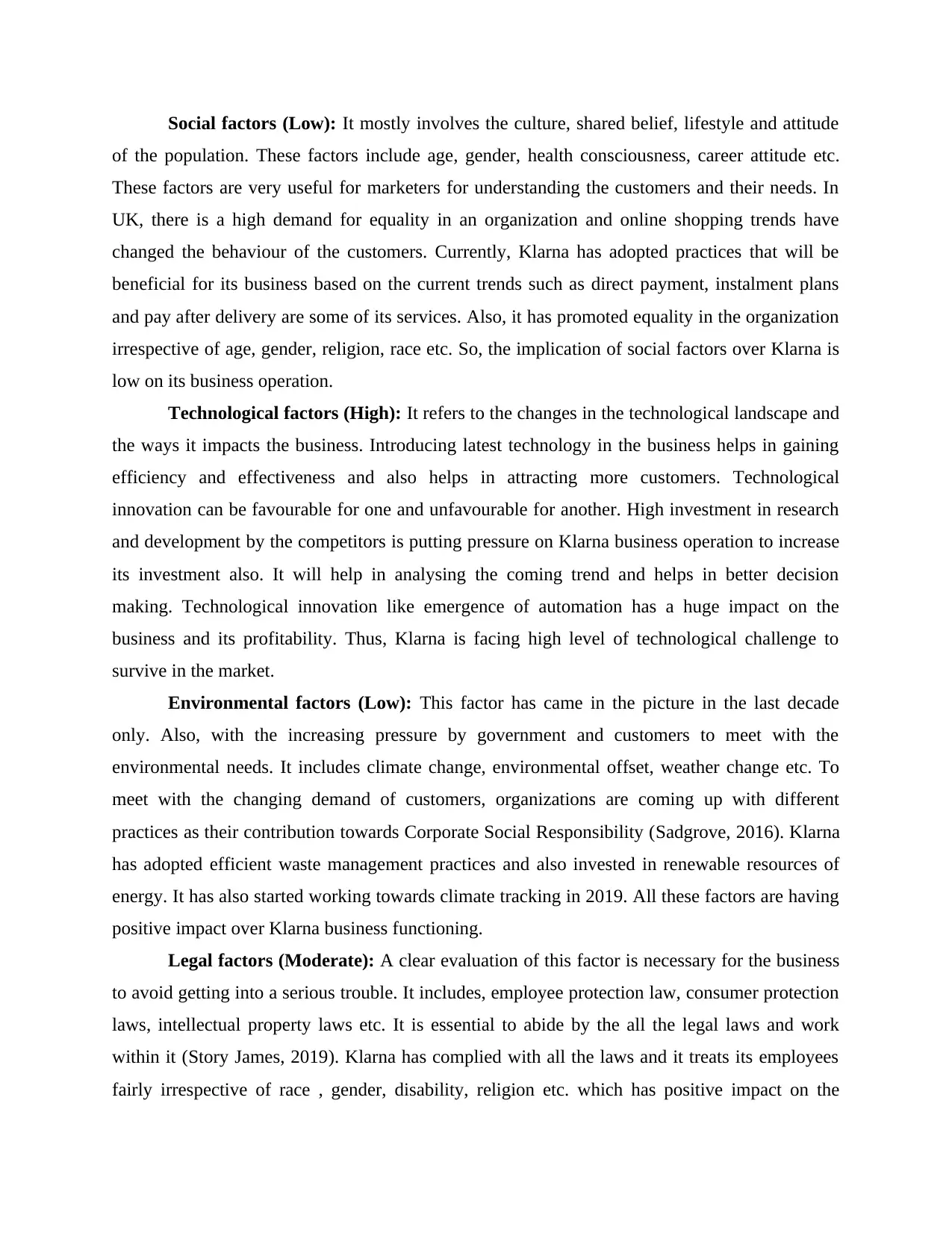
Social factors (Low): It mostly involves the culture, shared belief, lifestyle and attitude
of the population. These factors include age, gender, health consciousness, career attitude etc.
These factors are very useful for marketers for understanding the customers and their needs. In
UK, there is a high demand for equality in an organization and online shopping trends have
changed the behaviour of the customers. Currently, Klarna has adopted practices that will be
beneficial for its business based on the current trends such as direct payment, instalment plans
and pay after delivery are some of its services. Also, it has promoted equality in the organization
irrespective of age, gender, religion, race etc. So, the implication of social factors over Klarna is
low on its business operation.
Technological factors (High): It refers to the changes in the technological landscape and
the ways it impacts the business. Introducing latest technology in the business helps in gaining
efficiency and effectiveness and also helps in attracting more customers. Technological
innovation can be favourable for one and unfavourable for another. High investment in research
and development by the competitors is putting pressure on Klarna business operation to increase
its investment also. It will help in analysing the coming trend and helps in better decision
making. Technological innovation like emergence of automation has a huge impact on the
business and its profitability. Thus, Klarna is facing high level of technological challenge to
survive in the market.
Environmental factors (Low): This factor has came in the picture in the last decade
only. Also, with the increasing pressure by government and customers to meet with the
environmental needs. It includes climate change, environmental offset, weather change etc. To
meet with the changing demand of customers, organizations are coming up with different
practices as their contribution towards Corporate Social Responsibility (Sadgrove, 2016). Klarna
has adopted efficient waste management practices and also invested in renewable resources of
energy. It has also started working towards climate tracking in 2019. All these factors are having
positive impact over Klarna business functioning.
Legal factors (Moderate): A clear evaluation of this factor is necessary for the business
to avoid getting into a serious trouble. It includes, employee protection law, consumer protection
laws, intellectual property laws etc. It is essential to abide by the all the legal laws and work
within it (Story James, 2019). Klarna has complied with all the laws and it treats its employees
fairly irrespective of race , gender, disability, religion etc. which has positive impact on the
of the population. These factors include age, gender, health consciousness, career attitude etc.
These factors are very useful for marketers for understanding the customers and their needs. In
UK, there is a high demand for equality in an organization and online shopping trends have
changed the behaviour of the customers. Currently, Klarna has adopted practices that will be
beneficial for its business based on the current trends such as direct payment, instalment plans
and pay after delivery are some of its services. Also, it has promoted equality in the organization
irrespective of age, gender, religion, race etc. So, the implication of social factors over Klarna is
low on its business operation.
Technological factors (High): It refers to the changes in the technological landscape and
the ways it impacts the business. Introducing latest technology in the business helps in gaining
efficiency and effectiveness and also helps in attracting more customers. Technological
innovation can be favourable for one and unfavourable for another. High investment in research
and development by the competitors is putting pressure on Klarna business operation to increase
its investment also. It will help in analysing the coming trend and helps in better decision
making. Technological innovation like emergence of automation has a huge impact on the
business and its profitability. Thus, Klarna is facing high level of technological challenge to
survive in the market.
Environmental factors (Low): This factor has came in the picture in the last decade
only. Also, with the increasing pressure by government and customers to meet with the
environmental needs. It includes climate change, environmental offset, weather change etc. To
meet with the changing demand of customers, organizations are coming up with different
practices as their contribution towards Corporate Social Responsibility (Sadgrove, 2016). Klarna
has adopted efficient waste management practices and also invested in renewable resources of
energy. It has also started working towards climate tracking in 2019. All these factors are having
positive impact over Klarna business functioning.
Legal factors (Moderate): A clear evaluation of this factor is necessary for the business
to avoid getting into a serious trouble. It includes, employee protection law, consumer protection
laws, intellectual property laws etc. It is essential to abide by the all the legal laws and work
within it (Story James, 2019). Klarna has complied with all the laws and it treats its employees
fairly irrespective of race , gender, disability, religion etc. which has positive impact on the
Paraphrase This Document
Need a fresh take? Get an instant paraphrase of this document with our AI Paraphraser
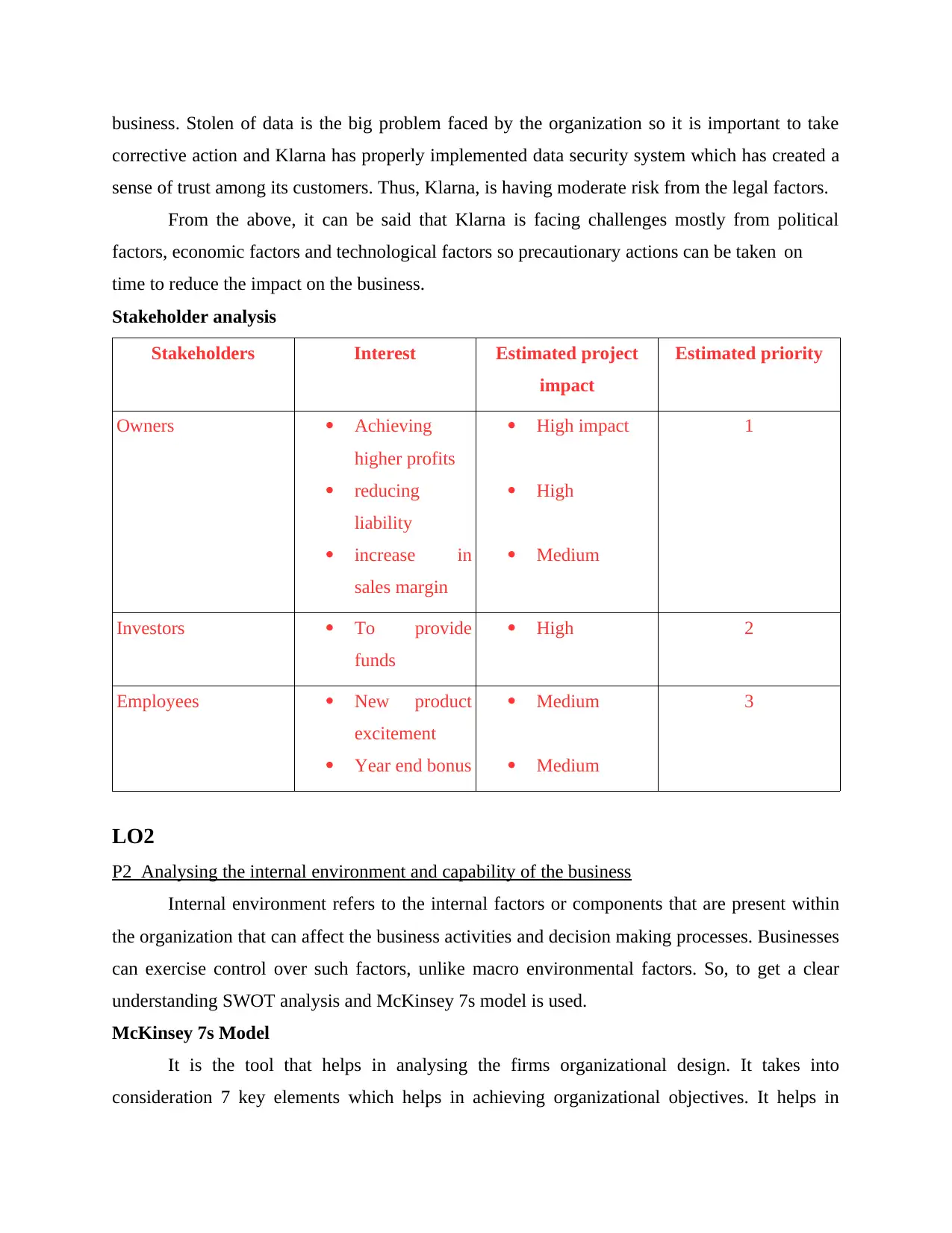
business. Stolen of data is the big problem faced by the organization so it is important to take
corrective action and Klarna has properly implemented data security system which has created a
sense of trust among its customers. Thus, Klarna, is having moderate risk from the legal factors.
From the above, it can be said that Klarna is facing challenges mostly from political
factors, economic factors and technological factors so precautionary actions can be taken on
time to reduce the impact on the business.
Stakeholder analysis
Stakeholders Interest Estimated project
impact
Estimated priority
Owners Achieving
higher profits
reducing
liability
increase in
sales margin
High impact
High
Medium
1
Investors To provide
funds
High 2
Employees New product
excitement
Year end bonus
Medium
Medium
3
LO2
P2 Analysing the internal environment and capability of the business
Internal environment refers to the internal factors or components that are present within
the organization that can affect the business activities and decision making processes. Businesses
can exercise control over such factors, unlike macro environmental factors. So, to get a clear
understanding SWOT analysis and McKinsey 7s model is used.
McKinsey 7s Model
It is the tool that helps in analysing the firms organizational design. It takes into
consideration 7 key elements which helps in achieving organizational objectives. It helps in
corrective action and Klarna has properly implemented data security system which has created a
sense of trust among its customers. Thus, Klarna, is having moderate risk from the legal factors.
From the above, it can be said that Klarna is facing challenges mostly from political
factors, economic factors and technological factors so precautionary actions can be taken on
time to reduce the impact on the business.
Stakeholder analysis
Stakeholders Interest Estimated project
impact
Estimated priority
Owners Achieving
higher profits
reducing
liability
increase in
sales margin
High impact
High
Medium
1
Investors To provide
funds
High 2
Employees New product
excitement
Year end bonus
Medium
Medium
3
LO2
P2 Analysing the internal environment and capability of the business
Internal environment refers to the internal factors or components that are present within
the organization that can affect the business activities and decision making processes. Businesses
can exercise control over such factors, unlike macro environmental factors. So, to get a clear
understanding SWOT analysis and McKinsey 7s model is used.
McKinsey 7s Model
It is the tool that helps in analysing the firms organizational design. It takes into
consideration 7 key elements which helps in achieving organizational objectives. It helps in
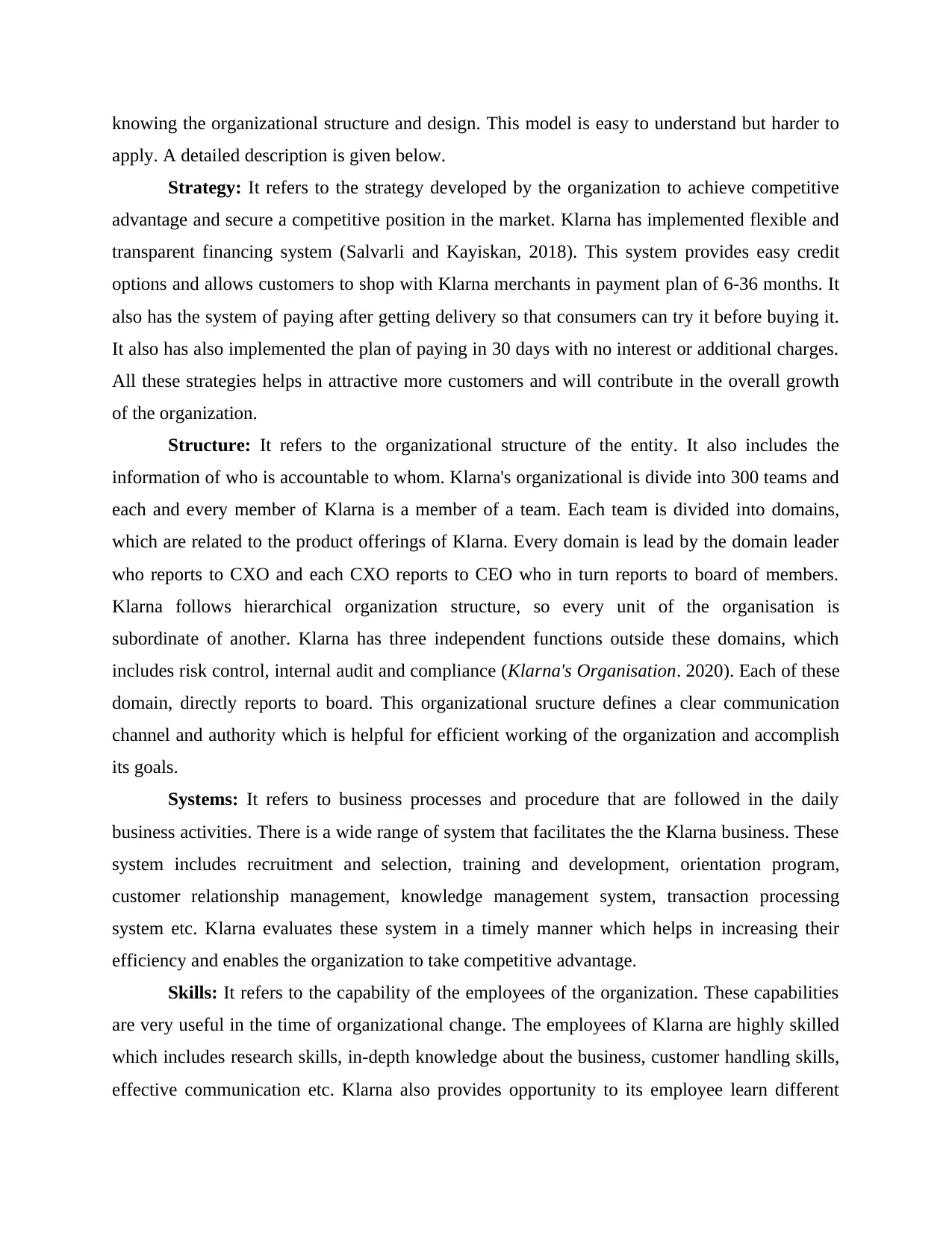
knowing the organizational structure and design. This model is easy to understand but harder to
apply. A detailed description is given below.
Strategy: It refers to the strategy developed by the organization to achieve competitive
advantage and secure a competitive position in the market. Klarna has implemented flexible and
transparent financing system (Salvarli and Kayiskan, 2018). This system provides easy credit
options and allows customers to shop with Klarna merchants in payment plan of 6-36 months. It
also has the system of paying after getting delivery so that consumers can try it before buying it.
It also has also implemented the plan of paying in 30 days with no interest or additional charges.
All these strategies helps in attractive more customers and will contribute in the overall growth
of the organization.
Structure: It refers to the organizational structure of the entity. It also includes the
information of who is accountable to whom. Klarna's organizational is divide into 300 teams and
each and every member of Klarna is a member of a team. Each team is divided into domains,
which are related to the product offerings of Klarna. Every domain is lead by the domain leader
who reports to CXO and each CXO reports to CEO who in turn reports to board of members.
Klarna follows hierarchical organization structure, so every unit of the organisation is
subordinate of another. Klarna has three independent functions outside these domains, which
includes risk control, internal audit and compliance (Klarna's Organisation. 2020). Each of these
domain, directly reports to board. This organizational sructure defines a clear communication
channel and authority which is helpful for efficient working of the organization and accomplish
its goals.
Systems: It refers to business processes and procedure that are followed in the daily
business activities. There is a wide range of system that facilitates the the Klarna business. These
system includes recruitment and selection, training and development, orientation program,
customer relationship management, knowledge management system, transaction processing
system etc. Klarna evaluates these system in a timely manner which helps in increasing their
efficiency and enables the organization to take competitive advantage.
Skills: It refers to the capability of the employees of the organization. These capabilities
are very useful in the time of organizational change. The employees of Klarna are highly skilled
which includes research skills, in-depth knowledge about the business, customer handling skills,
effective communication etc. Klarna also provides opportunity to its employee learn different
apply. A detailed description is given below.
Strategy: It refers to the strategy developed by the organization to achieve competitive
advantage and secure a competitive position in the market. Klarna has implemented flexible and
transparent financing system (Salvarli and Kayiskan, 2018). This system provides easy credit
options and allows customers to shop with Klarna merchants in payment plan of 6-36 months. It
also has the system of paying after getting delivery so that consumers can try it before buying it.
It also has also implemented the plan of paying in 30 days with no interest or additional charges.
All these strategies helps in attractive more customers and will contribute in the overall growth
of the organization.
Structure: It refers to the organizational structure of the entity. It also includes the
information of who is accountable to whom. Klarna's organizational is divide into 300 teams and
each and every member of Klarna is a member of a team. Each team is divided into domains,
which are related to the product offerings of Klarna. Every domain is lead by the domain leader
who reports to CXO and each CXO reports to CEO who in turn reports to board of members.
Klarna follows hierarchical organization structure, so every unit of the organisation is
subordinate of another. Klarna has three independent functions outside these domains, which
includes risk control, internal audit and compliance (Klarna's Organisation. 2020). Each of these
domain, directly reports to board. This organizational sructure defines a clear communication
channel and authority which is helpful for efficient working of the organization and accomplish
its goals.
Systems: It refers to business processes and procedure that are followed in the daily
business activities. There is a wide range of system that facilitates the the Klarna business. These
system includes recruitment and selection, training and development, orientation program,
customer relationship management, knowledge management system, transaction processing
system etc. Klarna evaluates these system in a timely manner which helps in increasing their
efficiency and enables the organization to take competitive advantage.
Skills: It refers to the capability of the employees of the organization. These capabilities
are very useful in the time of organizational change. The employees of Klarna are highly skilled
which includes research skills, in-depth knowledge about the business, customer handling skills,
effective communication etc. Klarna also provides opportunity to its employee learn different
⊘ This is a preview!⊘
Do you want full access?
Subscribe today to unlock all pages.

Trusted by 1+ million students worldwide
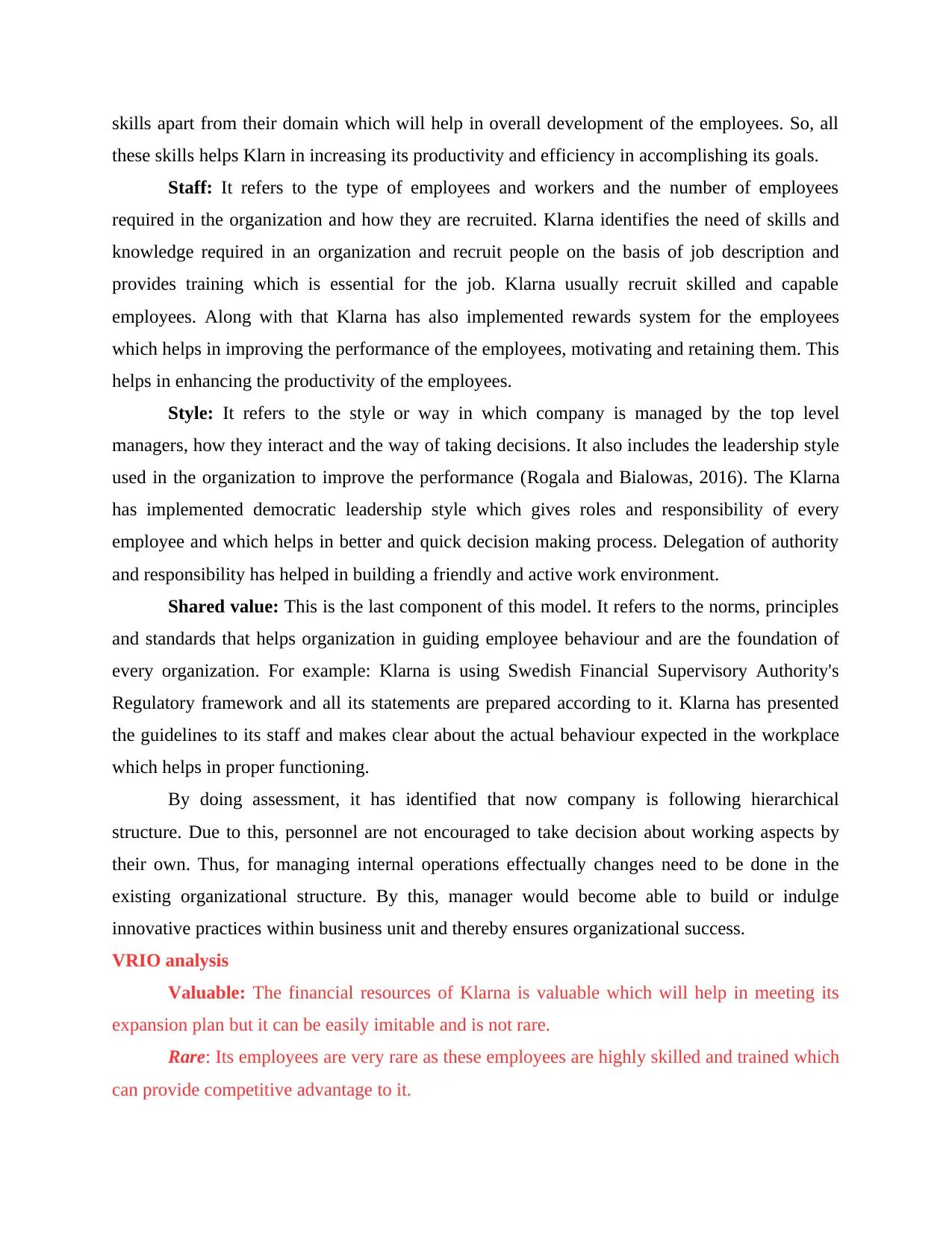
skills apart from their domain which will help in overall development of the employees. So, all
these skills helps Klarn in increasing its productivity and efficiency in accomplishing its goals.
Staff: It refers to the type of employees and workers and the number of employees
required in the organization and how they are recruited. Klarna identifies the need of skills and
knowledge required in an organization and recruit people on the basis of job description and
provides training which is essential for the job. Klarna usually recruit skilled and capable
employees. Along with that Klarna has also implemented rewards system for the employees
which helps in improving the performance of the employees, motivating and retaining them. This
helps in enhancing the productivity of the employees.
Style: It refers to the style or way in which company is managed by the top level
managers, how they interact and the way of taking decisions. It also includes the leadership style
used in the organization to improve the performance (Rogala and Bialowas, 2016). The Klarna
has implemented democratic leadership style which gives roles and responsibility of every
employee and which helps in better and quick decision making process. Delegation of authority
and responsibility has helped in building a friendly and active work environment.
Shared value: This is the last component of this model. It refers to the norms, principles
and standards that helps organization in guiding employee behaviour and are the foundation of
every organization. For example: Klarna is using Swedish Financial Supervisory Authority's
Regulatory framework and all its statements are prepared according to it. Klarna has presented
the guidelines to its staff and makes clear about the actual behaviour expected in the workplace
which helps in proper functioning.
By doing assessment, it has identified that now company is following hierarchical
structure. Due to this, personnel are not encouraged to take decision about working aspects by
their own. Thus, for managing internal operations effectually changes need to be done in the
existing organizational structure. By this, manager would become able to build or indulge
innovative practices within business unit and thereby ensures organizational success.
VRIO analysis
Valuable: The financial resources of Klarna is valuable which will help in meeting its
expansion plan but it can be easily imitable and is not rare.
Rare: Its employees are very rare as these employees are highly skilled and trained which
can provide competitive advantage to it.
these skills helps Klarn in increasing its productivity and efficiency in accomplishing its goals.
Staff: It refers to the type of employees and workers and the number of employees
required in the organization and how they are recruited. Klarna identifies the need of skills and
knowledge required in an organization and recruit people on the basis of job description and
provides training which is essential for the job. Klarna usually recruit skilled and capable
employees. Along with that Klarna has also implemented rewards system for the employees
which helps in improving the performance of the employees, motivating and retaining them. This
helps in enhancing the productivity of the employees.
Style: It refers to the style or way in which company is managed by the top level
managers, how they interact and the way of taking decisions. It also includes the leadership style
used in the organization to improve the performance (Rogala and Bialowas, 2016). The Klarna
has implemented democratic leadership style which gives roles and responsibility of every
employee and which helps in better and quick decision making process. Delegation of authority
and responsibility has helped in building a friendly and active work environment.
Shared value: This is the last component of this model. It refers to the norms, principles
and standards that helps organization in guiding employee behaviour and are the foundation of
every organization. For example: Klarna is using Swedish Financial Supervisory Authority's
Regulatory framework and all its statements are prepared according to it. Klarna has presented
the guidelines to its staff and makes clear about the actual behaviour expected in the workplace
which helps in proper functioning.
By doing assessment, it has identified that now company is following hierarchical
structure. Due to this, personnel are not encouraged to take decision about working aspects by
their own. Thus, for managing internal operations effectually changes need to be done in the
existing organizational structure. By this, manager would become able to build or indulge
innovative practices within business unit and thereby ensures organizational success.
VRIO analysis
Valuable: The financial resources of Klarna is valuable which will help in meeting its
expansion plan but it can be easily imitable and is not rare.
Rare: Its employees are very rare as these employees are highly skilled and trained which
can provide competitive advantage to it.
Paraphrase This Document
Need a fresh take? Get an instant paraphrase of this document with our AI Paraphraser
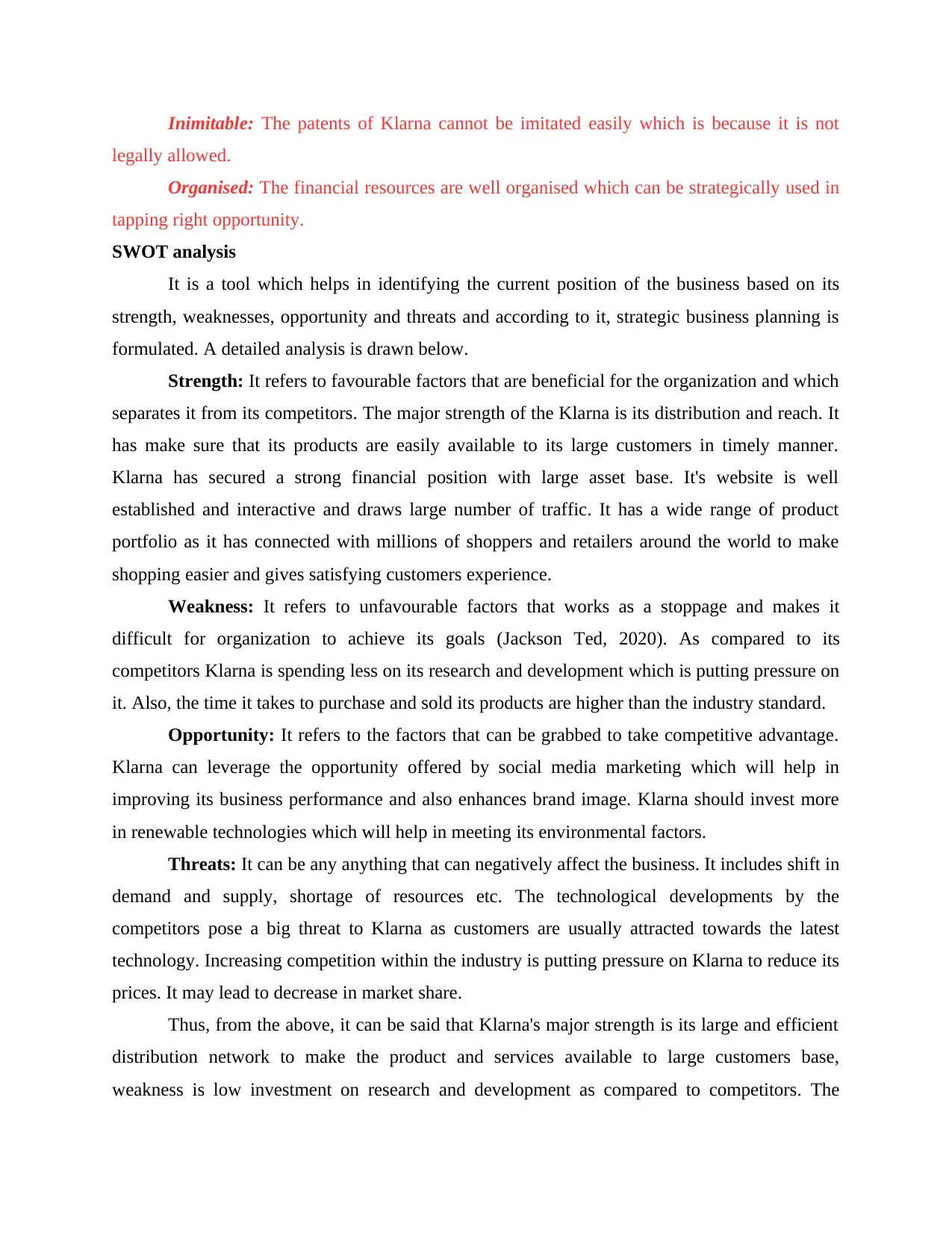
Inimitable: The patents of Klarna cannot be imitated easily which is because it is not
legally allowed.
Organised: The financial resources are well organised which can be strategically used in
tapping right opportunity.
SWOT analysis
It is a tool which helps in identifying the current position of the business based on its
strength, weaknesses, opportunity and threats and according to it, strategic business planning is
formulated. A detailed analysis is drawn below.
Strength: It refers to favourable factors that are beneficial for the organization and which
separates it from its competitors. The major strength of the Klarna is its distribution and reach. It
has make sure that its products are easily available to its large customers in timely manner.
Klarna has secured a strong financial position with large asset base. It's website is well
established and interactive and draws large number of traffic. It has a wide range of product
portfolio as it has connected with millions of shoppers and retailers around the world to make
shopping easier and gives satisfying customers experience.
Weakness: It refers to unfavourable factors that works as a stoppage and makes it
difficult for organization to achieve its goals (Jackson Ted, 2020). As compared to its
competitors Klarna is spending less on its research and development which is putting pressure on
it. Also, the time it takes to purchase and sold its products are higher than the industry standard.
Opportunity: It refers to the factors that can be grabbed to take competitive advantage.
Klarna can leverage the opportunity offered by social media marketing which will help in
improving its business performance and also enhances brand image. Klarna should invest more
in renewable technologies which will help in meeting its environmental factors.
Threats: It can be any anything that can negatively affect the business. It includes shift in
demand and supply, shortage of resources etc. The technological developments by the
competitors pose a big threat to Klarna as customers are usually attracted towards the latest
technology. Increasing competition within the industry is putting pressure on Klarna to reduce its
prices. It may lead to decrease in market share.
Thus, from the above, it can be said that Klarna's major strength is its large and efficient
distribution network to make the product and services available to large customers base,
weakness is low investment on research and development as compared to competitors. The
legally allowed.
Organised: The financial resources are well organised which can be strategically used in
tapping right opportunity.
SWOT analysis
It is a tool which helps in identifying the current position of the business based on its
strength, weaknesses, opportunity and threats and according to it, strategic business planning is
formulated. A detailed analysis is drawn below.
Strength: It refers to favourable factors that are beneficial for the organization and which
separates it from its competitors. The major strength of the Klarna is its distribution and reach. It
has make sure that its products are easily available to its large customers in timely manner.
Klarna has secured a strong financial position with large asset base. It's website is well
established and interactive and draws large number of traffic. It has a wide range of product
portfolio as it has connected with millions of shoppers and retailers around the world to make
shopping easier and gives satisfying customers experience.
Weakness: It refers to unfavourable factors that works as a stoppage and makes it
difficult for organization to achieve its goals (Jackson Ted, 2020). As compared to its
competitors Klarna is spending less on its research and development which is putting pressure on
it. Also, the time it takes to purchase and sold its products are higher than the industry standard.
Opportunity: It refers to the factors that can be grabbed to take competitive advantage.
Klarna can leverage the opportunity offered by social media marketing which will help in
improving its business performance and also enhances brand image. Klarna should invest more
in renewable technologies which will help in meeting its environmental factors.
Threats: It can be any anything that can negatively affect the business. It includes shift in
demand and supply, shortage of resources etc. The technological developments by the
competitors pose a big threat to Klarna as customers are usually attracted towards the latest
technology. Increasing competition within the industry is putting pressure on Klarna to reduce its
prices. It may lead to decrease in market share.
Thus, from the above, it can be said that Klarna's major strength is its large and efficient
distribution network to make the product and services available to large customers base,
weakness is low investment on research and development as compared to competitors. The
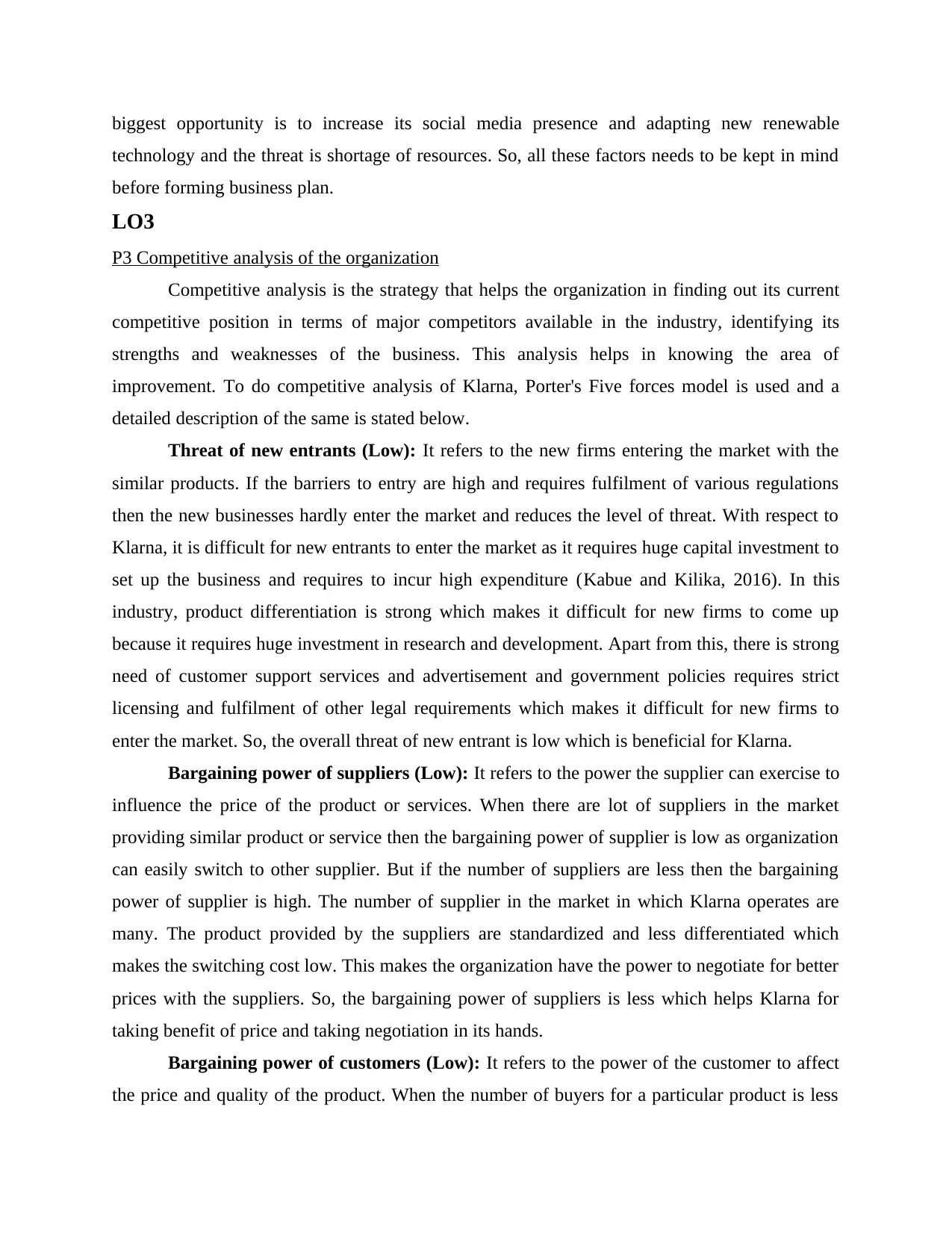
biggest opportunity is to increase its social media presence and adapting new renewable
technology and the threat is shortage of resources. So, all these factors needs to be kept in mind
before forming business plan.
LO3
P3 Competitive analysis of the organization
Competitive analysis is the strategy that helps the organization in finding out its current
competitive position in terms of major competitors available in the industry, identifying its
strengths and weaknesses of the business. This analysis helps in knowing the area of
improvement. To do competitive analysis of Klarna, Porter's Five forces model is used and a
detailed description of the same is stated below.
Threat of new entrants (Low): It refers to the new firms entering the market with the
similar products. If the barriers to entry are high and requires fulfilment of various regulations
then the new businesses hardly enter the market and reduces the level of threat. With respect to
Klarna, it is difficult for new entrants to enter the market as it requires huge capital investment to
set up the business and requires to incur high expenditure (Kabue and Kilika, 2016). In this
industry, product differentiation is strong which makes it difficult for new firms to come up
because it requires huge investment in research and development. Apart from this, there is strong
need of customer support services and advertisement and government policies requires strict
licensing and fulfilment of other legal requirements which makes it difficult for new firms to
enter the market. So, the overall threat of new entrant is low which is beneficial for Klarna.
Bargaining power of suppliers (Low): It refers to the power the supplier can exercise to
influence the price of the product or services. When there are lot of suppliers in the market
providing similar product or service then the bargaining power of supplier is low as organization
can easily switch to other supplier. But if the number of suppliers are less then the bargaining
power of supplier is high. The number of supplier in the market in which Klarna operates are
many. The product provided by the suppliers are standardized and less differentiated which
makes the switching cost low. This makes the organization have the power to negotiate for better
prices with the suppliers. So, the bargaining power of suppliers is less which helps Klarna for
taking benefit of price and taking negotiation in its hands.
Bargaining power of customers (Low): It refers to the power of the customer to affect
the price and quality of the product. When the number of buyers for a particular product is less
technology and the threat is shortage of resources. So, all these factors needs to be kept in mind
before forming business plan.
LO3
P3 Competitive analysis of the organization
Competitive analysis is the strategy that helps the organization in finding out its current
competitive position in terms of major competitors available in the industry, identifying its
strengths and weaknesses of the business. This analysis helps in knowing the area of
improvement. To do competitive analysis of Klarna, Porter's Five forces model is used and a
detailed description of the same is stated below.
Threat of new entrants (Low): It refers to the new firms entering the market with the
similar products. If the barriers to entry are high and requires fulfilment of various regulations
then the new businesses hardly enter the market and reduces the level of threat. With respect to
Klarna, it is difficult for new entrants to enter the market as it requires huge capital investment to
set up the business and requires to incur high expenditure (Kabue and Kilika, 2016). In this
industry, product differentiation is strong which makes it difficult for new firms to come up
because it requires huge investment in research and development. Apart from this, there is strong
need of customer support services and advertisement and government policies requires strict
licensing and fulfilment of other legal requirements which makes it difficult for new firms to
enter the market. So, the overall threat of new entrant is low which is beneficial for Klarna.
Bargaining power of suppliers (Low): It refers to the power the supplier can exercise to
influence the price of the product or services. When there are lot of suppliers in the market
providing similar product or service then the bargaining power of supplier is low as organization
can easily switch to other supplier. But if the number of suppliers are less then the bargaining
power of supplier is high. The number of supplier in the market in which Klarna operates are
many. The product provided by the suppliers are standardized and less differentiated which
makes the switching cost low. This makes the organization have the power to negotiate for better
prices with the suppliers. So, the bargaining power of suppliers is less which helps Klarna for
taking benefit of price and taking negotiation in its hands.
Bargaining power of customers (Low): It refers to the power of the customer to affect
the price and quality of the product. When the number of buyers for a particular product is less
⊘ This is a preview!⊘
Do you want full access?
Subscribe today to unlock all pages.

Trusted by 1+ million students worldwide
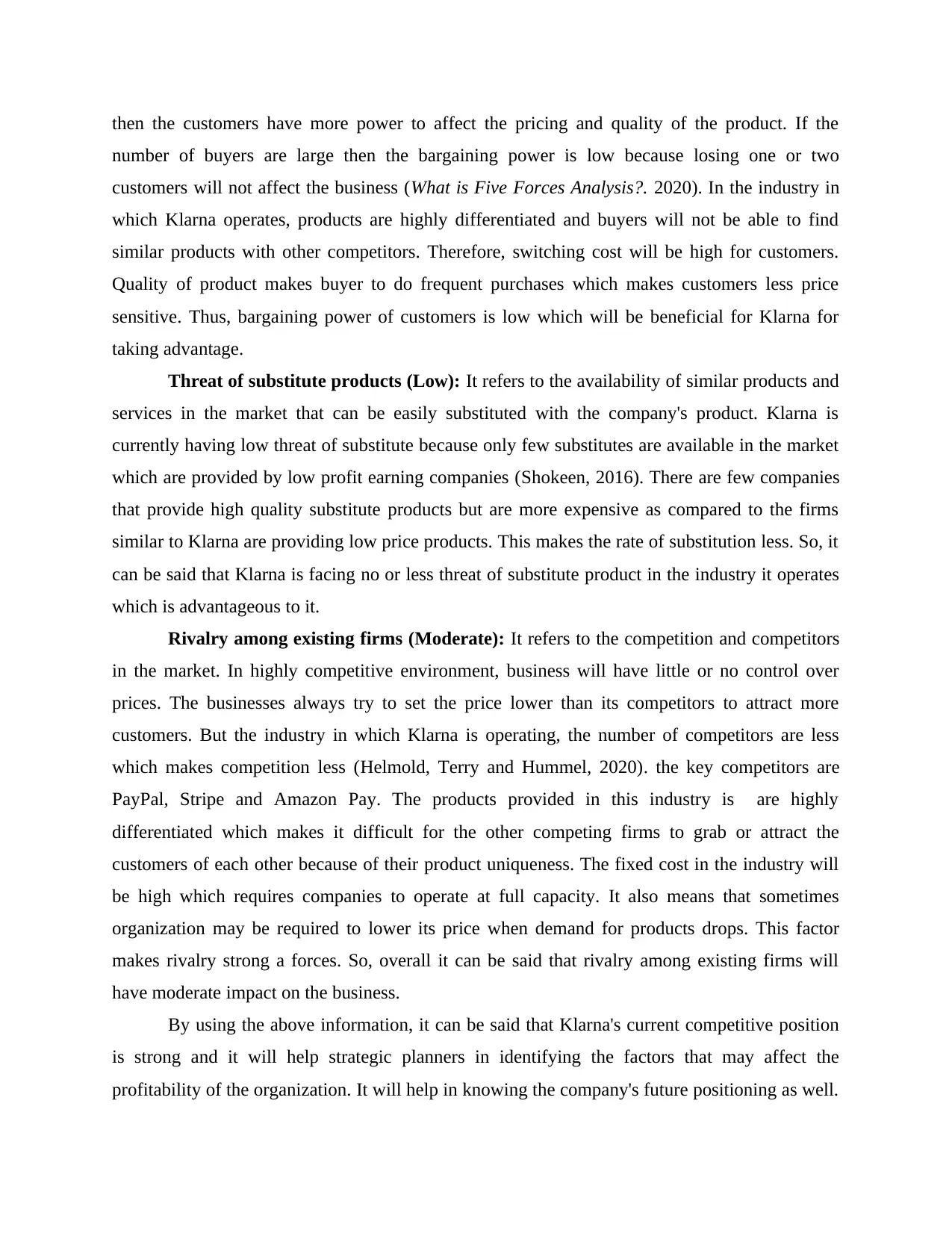
then the customers have more power to affect the pricing and quality of the product. If the
number of buyers are large then the bargaining power is low because losing one or two
customers will not affect the business (What is Five Forces Analysis?. 2020). In the industry in
which Klarna operates, products are highly differentiated and buyers will not be able to find
similar products with other competitors. Therefore, switching cost will be high for customers.
Quality of product makes buyer to do frequent purchases which makes customers less price
sensitive. Thus, bargaining power of customers is low which will be beneficial for Klarna for
taking advantage.
Threat of substitute products (Low): It refers to the availability of similar products and
services in the market that can be easily substituted with the company's product. Klarna is
currently having low threat of substitute because only few substitutes are available in the market
which are provided by low profit earning companies (Shokeen, 2016). There are few companies
that provide high quality substitute products but are more expensive as compared to the firms
similar to Klarna are providing low price products. This makes the rate of substitution less. So, it
can be said that Klarna is facing no or less threat of substitute product in the industry it operates
which is advantageous to it.
Rivalry among existing firms (Moderate): It refers to the competition and competitors
in the market. In highly competitive environment, business will have little or no control over
prices. The businesses always try to set the price lower than its competitors to attract more
customers. But the industry in which Klarna is operating, the number of competitors are less
which makes competition less (Helmold, Terry and Hummel, 2020). the key competitors are
PayPal, Stripe and Amazon Pay. The products provided in this industry is are highly
differentiated which makes it difficult for the other competing firms to grab or attract the
customers of each other because of their product uniqueness. The fixed cost in the industry will
be high which requires companies to operate at full capacity. It also means that sometimes
organization may be required to lower its price when demand for products drops. This factor
makes rivalry strong a forces. So, overall it can be said that rivalry among existing firms will
have moderate impact on the business.
By using the above information, it can be said that Klarna's current competitive position
is strong and it will help strategic planners in identifying the factors that may affect the
profitability of the organization. It will help in knowing the company's future positioning as well.
number of buyers are large then the bargaining power is low because losing one or two
customers will not affect the business (What is Five Forces Analysis?. 2020). In the industry in
which Klarna operates, products are highly differentiated and buyers will not be able to find
similar products with other competitors. Therefore, switching cost will be high for customers.
Quality of product makes buyer to do frequent purchases which makes customers less price
sensitive. Thus, bargaining power of customers is low which will be beneficial for Klarna for
taking advantage.
Threat of substitute products (Low): It refers to the availability of similar products and
services in the market that can be easily substituted with the company's product. Klarna is
currently having low threat of substitute because only few substitutes are available in the market
which are provided by low profit earning companies (Shokeen, 2016). There are few companies
that provide high quality substitute products but are more expensive as compared to the firms
similar to Klarna are providing low price products. This makes the rate of substitution less. So, it
can be said that Klarna is facing no or less threat of substitute product in the industry it operates
which is advantageous to it.
Rivalry among existing firms (Moderate): It refers to the competition and competitors
in the market. In highly competitive environment, business will have little or no control over
prices. The businesses always try to set the price lower than its competitors to attract more
customers. But the industry in which Klarna is operating, the number of competitors are less
which makes competition less (Helmold, Terry and Hummel, 2020). the key competitors are
PayPal, Stripe and Amazon Pay. The products provided in this industry is are highly
differentiated which makes it difficult for the other competing firms to grab or attract the
customers of each other because of their product uniqueness. The fixed cost in the industry will
be high which requires companies to operate at full capacity. It also means that sometimes
organization may be required to lower its price when demand for products drops. This factor
makes rivalry strong a forces. So, overall it can be said that rivalry among existing firms will
have moderate impact on the business.
By using the above information, it can be said that Klarna's current competitive position
is strong and it will help strategic planners in identifying the factors that may affect the
profitability of the organization. It will help in knowing the company's future positioning as well.
Paraphrase This Document
Need a fresh take? Get an instant paraphrase of this document with our AI Paraphraser
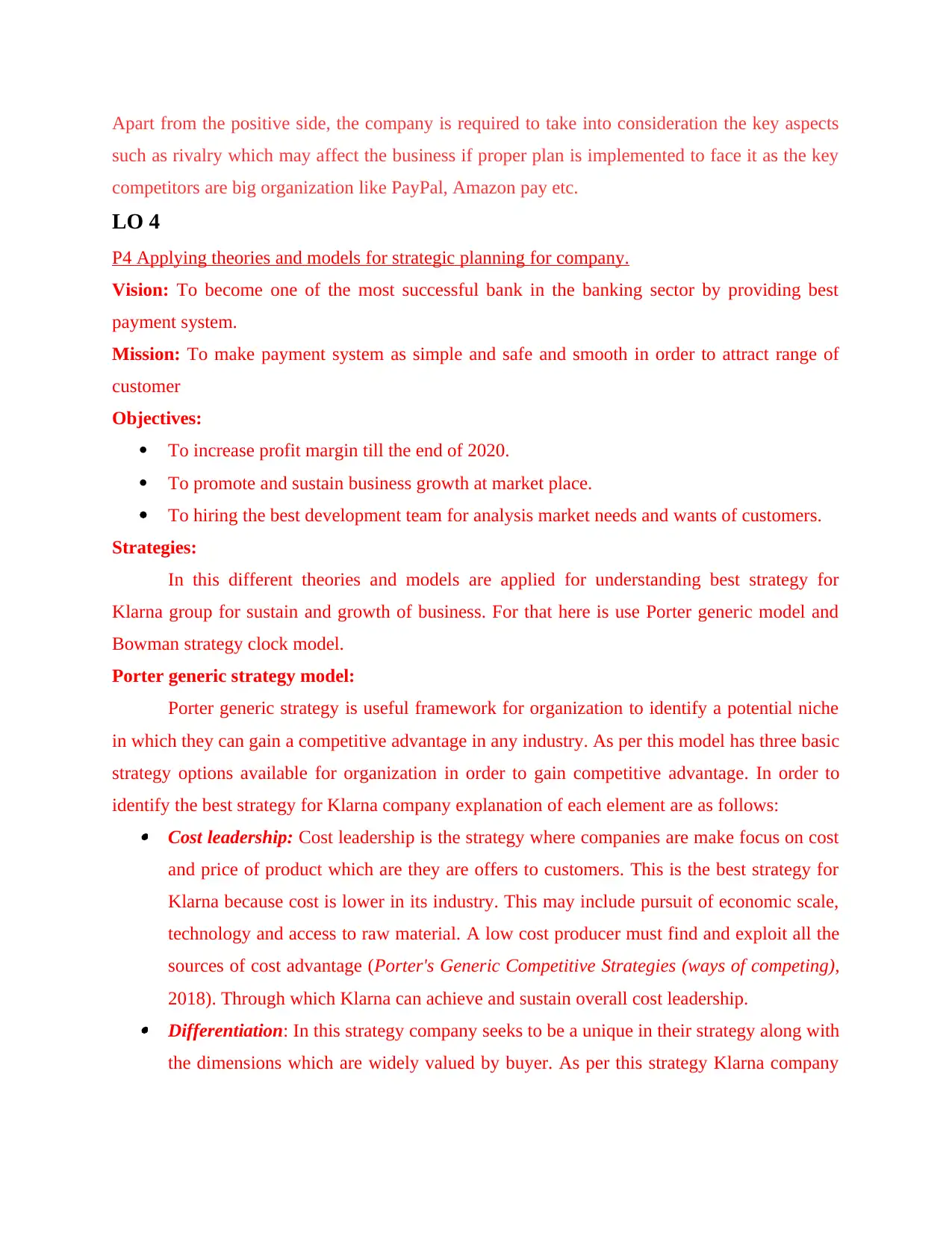
Apart from the positive side, the company is required to take into consideration the key aspects
such as rivalry which may affect the business if proper plan is implemented to face it as the key
competitors are big organization like PayPal, Amazon pay etc.
LO 4
P4 Applying theories and models for strategic planning for company.
Vision: To become one of the most successful bank in the banking sector by providing best
payment system.
Mission: To make payment system as simple and safe and smooth in order to attract range of
customer
Objectives:
To increase profit margin till the end of 2020.
To promote and sustain business growth at market place.
To hiring the best development team for analysis market needs and wants of customers.
Strategies:
In this different theories and models are applied for understanding best strategy for
Klarna group for sustain and growth of business. For that here is use Porter generic model and
Bowman strategy clock model.
Porter generic strategy model:
Porter generic strategy is useful framework for organization to identify a potential niche
in which they can gain a competitive advantage in any industry. As per this model has three basic
strategy options available for organization in order to gain competitive advantage. In order to
identify the best strategy for Klarna company explanation of each element are as follows: Cost leadership: Cost leadership is the strategy where companies are make focus on cost
and price of product which are they are offers to customers. This is the best strategy for
Klarna because cost is lower in its industry. This may include pursuit of economic scale,
technology and access to raw material. A low cost producer must find and exploit all the
sources of cost advantage (Porter's Generic Competitive Strategies (ways of competing),
2018). Through which Klarna can achieve and sustain overall cost leadership. Differentiation: In this strategy company seeks to be a unique in their strategy along with
the dimensions which are widely valued by buyer. As per this strategy Klarna company
such as rivalry which may affect the business if proper plan is implemented to face it as the key
competitors are big organization like PayPal, Amazon pay etc.
LO 4
P4 Applying theories and models for strategic planning for company.
Vision: To become one of the most successful bank in the banking sector by providing best
payment system.
Mission: To make payment system as simple and safe and smooth in order to attract range of
customer
Objectives:
To increase profit margin till the end of 2020.
To promote and sustain business growth at market place.
To hiring the best development team for analysis market needs and wants of customers.
Strategies:
In this different theories and models are applied for understanding best strategy for
Klarna group for sustain and growth of business. For that here is use Porter generic model and
Bowman strategy clock model.
Porter generic strategy model:
Porter generic strategy is useful framework for organization to identify a potential niche
in which they can gain a competitive advantage in any industry. As per this model has three basic
strategy options available for organization in order to gain competitive advantage. In order to
identify the best strategy for Klarna company explanation of each element are as follows: Cost leadership: Cost leadership is the strategy where companies are make focus on cost
and price of product which are they are offers to customers. This is the best strategy for
Klarna because cost is lower in its industry. This may include pursuit of economic scale,
technology and access to raw material. A low cost producer must find and exploit all the
sources of cost advantage (Porter's Generic Competitive Strategies (ways of competing),
2018). Through which Klarna can achieve and sustain overall cost leadership. Differentiation: In this strategy company seeks to be a unique in their strategy along with
the dimensions which are widely valued by buyer. As per this strategy Klarna company
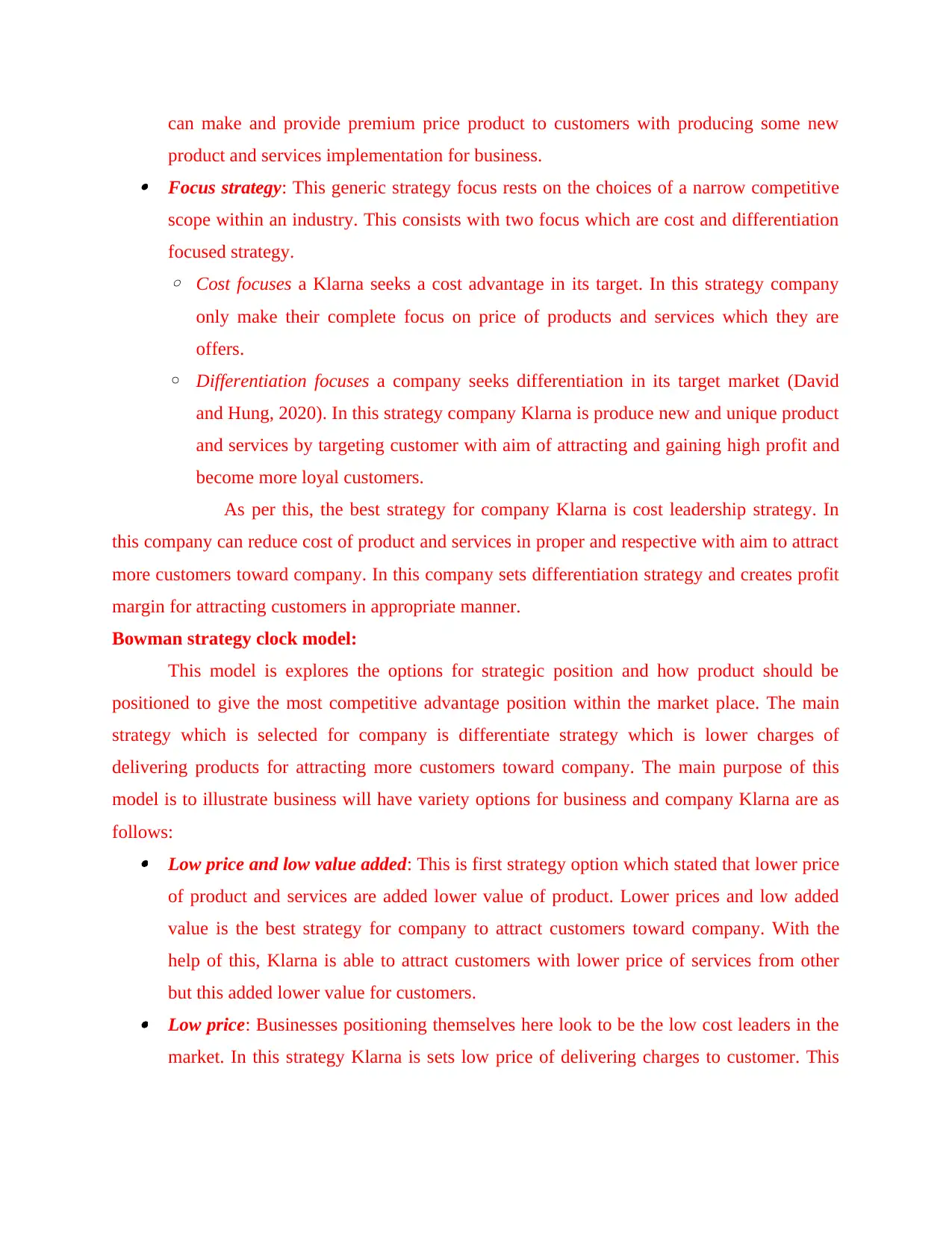
can make and provide premium price product to customers with producing some new
product and services implementation for business. Focus strategy: This generic strategy focus rests on the choices of a narrow competitive
scope within an industry. This consists with two focus which are cost and differentiation
focused strategy.
◦ Cost focuses a Klarna seeks a cost advantage in its target. In this strategy company
only make their complete focus on price of products and services which they are
offers.
◦ Differentiation focuses a company seeks differentiation in its target market (David
and Hung, 2020). In this strategy company Klarna is produce new and unique product
and services by targeting customer with aim of attracting and gaining high profit and
become more loyal customers.
As per this, the best strategy for company Klarna is cost leadership strategy. In
this company can reduce cost of product and services in proper and respective with aim to attract
more customers toward company. In this company sets differentiation strategy and creates profit
margin for attracting customers in appropriate manner.
Bowman strategy clock model:
This model is explores the options for strategic position and how product should be
positioned to give the most competitive advantage position within the market place. The main
strategy which is selected for company is differentiate strategy which is lower charges of
delivering products for attracting more customers toward company. The main purpose of this
model is to illustrate business will have variety options for business and company Klarna are as
follows: Low price and low value added: This is first strategy option which stated that lower price
of product and services are added lower value of product. Lower prices and low added
value is the best strategy for company to attract customers toward company. With the
help of this, Klarna is able to attract customers with lower price of services from other
but this added lower value for customers. Low price: Businesses positioning themselves here look to be the low cost leaders in the
market. In this strategy Klarna is sets low price of delivering charges to customer. This
product and services implementation for business. Focus strategy: This generic strategy focus rests on the choices of a narrow competitive
scope within an industry. This consists with two focus which are cost and differentiation
focused strategy.
◦ Cost focuses a Klarna seeks a cost advantage in its target. In this strategy company
only make their complete focus on price of products and services which they are
offers.
◦ Differentiation focuses a company seeks differentiation in its target market (David
and Hung, 2020). In this strategy company Klarna is produce new and unique product
and services by targeting customer with aim of attracting and gaining high profit and
become more loyal customers.
As per this, the best strategy for company Klarna is cost leadership strategy. In
this company can reduce cost of product and services in proper and respective with aim to attract
more customers toward company. In this company sets differentiation strategy and creates profit
margin for attracting customers in appropriate manner.
Bowman strategy clock model:
This model is explores the options for strategic position and how product should be
positioned to give the most competitive advantage position within the market place. The main
strategy which is selected for company is differentiate strategy which is lower charges of
delivering products for attracting more customers toward company. The main purpose of this
model is to illustrate business will have variety options for business and company Klarna are as
follows: Low price and low value added: This is first strategy option which stated that lower price
of product and services are added lower value of product. Lower prices and low added
value is the best strategy for company to attract customers toward company. With the
help of this, Klarna is able to attract customers with lower price of services from other
but this added lower value for customers. Low price: Businesses positioning themselves here look to be the low cost leaders in the
market. In this strategy Klarna is sets low price of delivering charges to customer. This
⊘ This is a preview!⊘
Do you want full access?
Subscribe today to unlock all pages.

Trusted by 1+ million students worldwide
1 out of 18
Related Documents
Your All-in-One AI-Powered Toolkit for Academic Success.
+13062052269
info@desklib.com
Available 24*7 on WhatsApp / Email
![[object Object]](/_next/static/media/star-bottom.7253800d.svg)
Unlock your academic potential
Copyright © 2020–2025 A2Z Services. All Rights Reserved. Developed and managed by ZUCOL.





